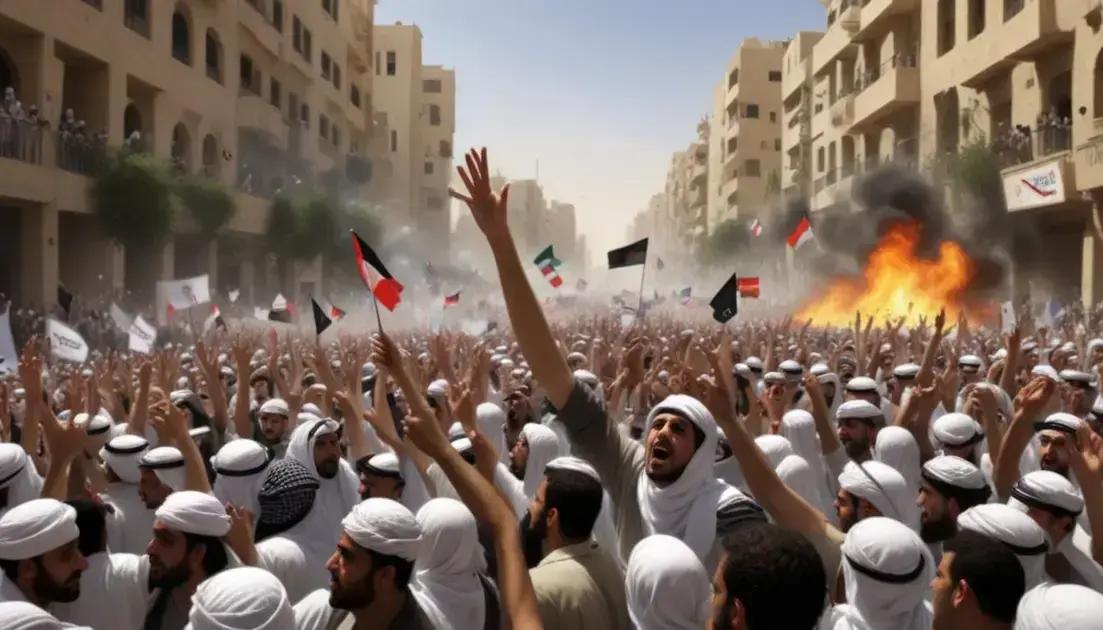
Arab Spring 2019: Renewal of Revolts and Technology
The Arab Spring sparked significant social movements in the Middle East and North Africa, highlighting public demands for democracy and transparency. Technology played a crucial role, enabling protests and connecting citizens. Countries experienced shifts in governance, with some moving toward democracy while others faced challenges. The reactions of international powers also evolved in response to these uprisings, emphasizing the global implications of local struggles for rights and justice.
Arab Spring re-emerges in 2019 as social media fuels protests across the Middle East and North Africa. Will this lead to lasting change?
The Background of the Arab Spring
The Arab Spring began in late 2010 in Tunisia. It started with a young man named Mohamed Bouazizi. He faced injustice when officials declined to address his complaints about harassment. This sparked protests not just in Tunisia, but across the Arab world.
People were tired of corruption and poor living conditions. They wanted freedom and better rights. Social media played a huge role in spreading the word. Platforms like Facebook and Twitter helped protesters connect and organize.
Key Events Leading up to the Arab Spring
Before the Arab Spring, many countries faced unrest. High unemployment and rising prices were common issues. In countries like Egypt and Libya, people felt increasingly frustrated.
Public protests grew in size. Soon, they evolved into calls for change. Leaders who had been in power for decades faced strong opposition. The people were united by a desire for democracy and accountability.
The Role of Social Media
Social media was a game-changer during the Arab Spring. It allowed activists to share information quickly. Videos and photos of marches and demonstrations went viral. This global attention put pressure on governments to respond.
Citizens used these platforms to mobilize supporters and share their stories. It fostered a sense of community among protesters. The power of social media cannot be underestimated. It helped to amplify their messages and garner international support.
Major Protests of 2019
The year 2019 was full of major protests across the Arab world. Citizens stood up for their rights and freedoms like never before. Social media helped spread news fast. People shared their experiences and called for change.
Sudan saw a huge uprising in 2019. Protesters demanded the end of President Omar al-Bashir’s rule. They took to the streets for months. Eventually, their efforts paid off. In April, he was removed from power after a 30-year rule.
Algeria also faced widespread protests. People wanted President Abdelaziz Bouteflika to resign. His decision to run for a fifth term sparked anger. Mass demonstrations pushed him to step down in April.
Lebanon’s Protests
Lebanon joined in the protests later in 2019. People protested against economic issues and government corruption. They took to the streets demanding better living conditions. The slogan “#YouStink” became popular for a reason. The garbage problem in Beirut symbolized wider discontent.
Iraq’s Uprising
Iraq experienced significant protests too. Citizens expressed frustration over poverty and lack of jobs. Demonstrators sought accountability from their leaders. They called out the government for corruption and mismanagement.
These 2019 protests showed a strong desire for change. People were united in their demands for justice and accountability. The spirit of the Arab Spring lived on through these movements.
Role of Technology in Social Movements
The role of technology in social movements is crucial today. It helps people connect and share their stories. Social media platforms like Twitter and Facebook create a space for dialogue.
In the Arab Spring, technology was a key player. Activists used smartphones to document protests. They shared videos and images that went viral. This caught the world’s attention.
Mobilizing Support
Technology makes it easier to mobilize support. People can join movements from anywhere. Online petitions and hashtags spread awareness quickly. For example, the hashtag #ArabSpring linked various protests together.
Coordinating Actions
Modern technology helps protestors coordinate their actions. Apps enable them to plan meetings and share information. This effective organization can lead to larger crowds at protests. More participants raise the movement’s visibility.
Moreover, social media acts as a real-time news source. Protesters can inform the public about what’s happening on the ground. This transparency builds trust and support from around the globe.
Impact on International Relations
The impact of the Arab Spring on international relations has been significant. These movements changed how countries interact with one another. Governments around the world watched closely as protests spread.
Countries like the United States faced tough questions. They had to decide how to respond to uprisings in the Middle East. Support for dictators was once common, but that started to change.
Shifts in Foreign Policy
The Arab Spring led many nations to rethink their foreign policies. They began supporting democracy more openly. Nations looked for ways to help those fighting for freedom.
Reactions from Regional Powers
Regional powers also changed their approach. Countries like Saudi Arabia reacted strongly to protests. They worried about the spillover effect in their nations. Some rulers offered financial aid and military support to stay in power.
These reactions sparked debates in other nations too. Many people called for stronger support of human rights. Activists argued that ignoring these issues can lead to long-term instability.
Overall, the Arab Spring reshaped global perspectives. It showed how social movements could influence international politics. As people fought for their rights, they also changed the world stage.
Future of Governance in Affected Nations
The future of governance in affected nations is uncertain yet promising. The Arab Spring sparked hopes for democracy and reform. Many people are still fighting for their voices to be heard. They want governments that listen and respond.
In countries like Tunisia, there have been steps toward democracy. They held free elections and created a constitution. However, challenges remain. Political parties must unite to strengthen the system.
Challenges Ahead
In other nations, like Egypt, the road is tougher. After initial hopes, many faced repression. Activists still push for change, even with strict rules. They remind the world of their demands for rights.
The Role of Civil Society
Civil society plays a vital role in shaping governance. Non-governmental organizations (NGOs) work to promote human rights. They help educate citizens about their rights and responsibilities. This knowledge is crucial for a healthy democracy.
Social media continues to empower young people. They are using digital platforms to organize and engage. This builds a new generation’s commitment to democratic values.
The landscape is changing, and changes are happening slowly. The people’s push for reform influences governance every day. As they demand accountability, leaders must adapt or risk losing power.
Conclusion
In conclusion, the Arab Spring and its aftermath have reshaped nations across the Middle East and North Africa. The quest for democracy and justice continues to inspire many. While challenges remain, the voices of the people are growing stronger.
Technology has played a crucial role in these movements, helping citizens connect and organize. As countries navigate their future, the importance of civil society and active participation cannot be overstated.
Governments must adapt to the demands of their people or face serious consequences. Ultimately, the future of governance in these nations depends on listening to the public and embracing change. The journey towards true democracy and accountability is ongoing, and every step counts.


